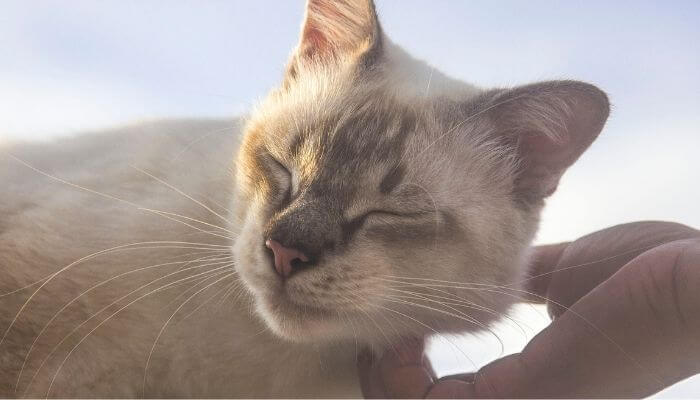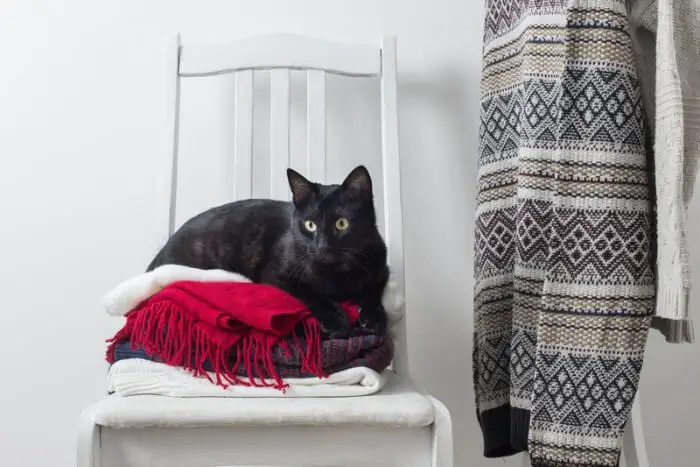Cats are ticklish, but not in the same way that humans are.
Cats aren’t going to start laughing when you tickle them in the right spot but they are very sensitive to touch.
Some cats may enjoy being tickled for a short amount of time but the sensation can quickly become irritating or itchy so keep an eye on your cat’s behaviour to avoid getting scratched or swatted.
Contents
Do Cats Like Being Tickled?
Every cat is different so don’t assume your cat is going to enjoy tickles.
The best time to tickle your cat is when they come to you for attention.

Be gentle, watch your cat’s behaviour and respond accordingly.
In some way or another, most cats are ticklish so you are like to see a positive or negative reaction from your cat.
Cat Reactions To Tickling
Just like humans, each cat responds to tickling in different ways.
Some enjoy the sensation while others may try to swat your hand away.
It’s likely your cat will only tolerate a short amount of tickling before they have had enough.
This is because the sensation of tickling can become overstimulating quite quickly.
It’s important to understand your cat’s body language so you know whether they like the tickles or not.
If you don’t watch their body language your cat may get upset with you and you may end up being scratched or bitten.
These are common behaviours to look out for:
Positive Reactions
- Purring – if your cat is purring it is a good sign that they are enjoying the attention and feeling relaxed.
- Chirping and short, high pitched meows – these are sounds a cat makes when they feel content.
- Nudging your hand – if you stop tickling your cat they might nudge your hand to get you to carry on, this is a great sign that they are enjoying it and don’t want you to stop.
- Kneading – if your cat is kneading then it’s a sign they are feeling comfortable with the petting.
Negative Reactions
- Tense Body – if your cat gets tense then you should stop tickling them immediately.
- Hissing and growling – noises such as hissing and growling are clear signs that your cat doesn’t like what you are doing and you should stop immediately.
- Deep, long meows – this is a noise that indicates your cat is agitated and isn’t enjoying being tickled.
- Swiping at you – if your cat swipes at you with their paws they are trying to get you to stop.
If you aren’t paying attention you could think your cat is being playful when they are actually trying to communicate their discomfort to you.
Only tickle your cat when you can pay full attention to them.
Short Tickle Sessions Are Best
If your cat seems to enjoy being tickled, keep the tickling sessions short and let your cat move away from you if they’ve had enough.
Avoid making sudden movements and stop when your cat doesn’t seem to be enjoying it as much.

It’s best to start tickling your cat at the top of the head and work your way to other areas.
Skin can quickly become overstimulated which can turn what was pleasurable into discomfort.
This is why your cat may suddenly react negatively to being tickled even if they seemed to like it at first.
If this happens, stop tickling your cat and remember to keep tickle sessions short in the future.
Tickling Won’t Make Your Cat Laugh
Cats can’t laugh or smile so don’t expect a big reaction when you tickle them.
They don’t experience “gargalesis” which is a form of heavier tickling that leads to giggling and involuntary muscle spasms (like those seen when tickling humans and primates).
Cats experience another kind of tickling called “knismesis”, which is a light tickle that is often irritating or causes an itching sensation.
Where Are Cats Most Ticklish?
The most ticklish spots on a cat are the face, head, neck and paws.
Most cats enjoy being petted in these areas and they generally respond well to short, light tickles in these areas.
As cat’s paws are so sensitive, even the lightest touch can be extremely ticklish and cat’s reactions vary greatly to having their paws touched.

These are areas that are very sensitive and your cat will respond to even light touches.
There are some sensitive areas that cat’s don’t enjoy tickles, namely their tummy and their tail.
While a cat’s belly is ticklish too it is so sensitive that your cat will likely try to scratch you if you tickle them there so its best not to try.
If your cat lays on their back and shows you their belly this isn’t an invitation for you to tickle them.
This behaviour could mean that they are showing you they trust you, that they are feeling playful or even that they are going into this position as a defence.
Another area that is best avoided is their tail as many cats do not enjoy having their tail touched let alone tickled.
Are Cats Ticklish – Summary
Cats are ticklish but they won’t laugh when you tickle them.
Some cats enjoy the sensation but it quickly becomes overstimulating so only tickle them for a short amount of time.
It is important to understand your cat’s body language so you know if they want you to keep tickling them or not.
Don’t try to tickle your cat if they seem agitated, they won’t enjoy it.
As an Amazon Associate I may earn a small fee from qualifying purchases at no extra cost to you. This helps us run the site, so thanks for your support!








Leave a Comment